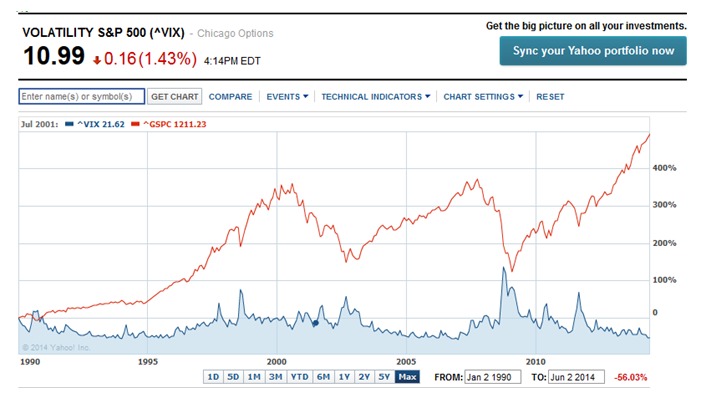While the media likes to tout the “new all-time high” every time the market finishes with an up day, don’t be either lulled into complacency or scared off thinking the end must be near.
Let’s try to find a little perspective.
The first chart is a graph of the S&P 500 and the VIX, the volatility index, back to 1990. This is a linear graph. The S&P is the red line and the VIX is the blue mountain chart immediately below.
We’ll come back to the VIX in a minute, but just looking at the S&P, it’s easy to come to the conclusion that this rally is getting into the “extended” period.
From the 2009 bottom this rally exceeds the 2002-2007 rally and is nearing the 1990-2000 rally in about half the time.
But let’s look at the same graph in a different way — using a log scale instead of a linear one.
The difference for the non-statistician is a linear scale represents a 100-point move in the market the same way — whether the market is at 331.89 as it was in 1990, or if it’s over 1900 as it is today.
The same chart viewed on a log scale shows the S&P 500’s path where each price point on the scale represents an equal percentage move vs. a price move. So today a 100-point change represents about a 5% market move vs. a 30% change back in 1990.
State of the market
Viewed this way, the current market rally looks far less spectacular. While the current rally is a 165% gain from the financial crisis bottom, it’s only a 37% gain from the 2000 pre-tech wreck market high. 37% over 14 years is far from “extended.”
By comparison Crestmont Research has broken down the market since 1900 and identified four secular or long-term bull-market cycles. The average length is 13.5 years and has seen the market index increase by an average of 810% during those cycles.
That’s not to say the market will go up like a rocket for another dozen years or so. This is why I included a graph of the VIX, or volatility index in the graphs above. Two points to make. First, the VIX is near historic lows. Second, while the market historically does well during times of low volatility, higher volatility does not necessarily mean an immediate correction.
The market was very volatile during a rather spectacular 1997-1999 period. While increased volatility is typically a prelude to a market correction, notice that the spikes come at market bottoms, not tops.
The bottom line is that the market is not in unprecedented territory. Increased volatility can be expected from an historical perspective. Macro conditions in China and Europe are throwing out red flags. But increased volatility does not mean a market top is imminent either. New market highs are a good thing. Let’s hope we get a chance to get used to them.
For more on Covestor’s services, visit Covestor.com or try a free trial.
Disclaimer: All investments involve risk and various investment strategies will not always be profitable. Neither the information nor any opinions expressed constitutes investment advice. Past performance does not guarantee future results.





